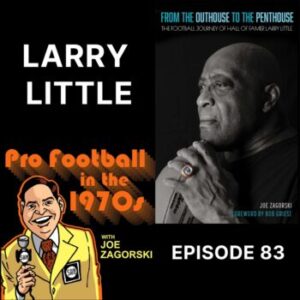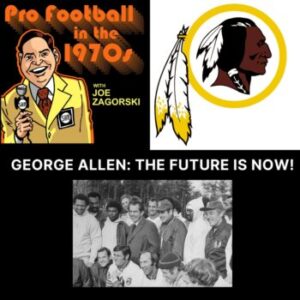Jim Finks could have spent his life as the answer to this trivia question, who beat out Hall of Famer Johnny Unitas as starting quarterback of the 1955 Pittsburgh Steelers?
Finks finished that 1955 season by leading the NFL in pass attempts, completions, passing yards and 10 touchdowns. He also threw 26 interceptions which might have been the last straw for Finks. He retired after that season.
Fortunately for the NFL, especially the Minnesota Vikings, Chicago Bears and New Orleans Saints, the end of Finks’ playing days kicked off his Pro Football Hall of Fame career as a builder of winners.
*** The photos in this article were sourced from the Jim Finks Foundation website. We recommend you take a look and learn more about Jim, as well as the foundation in his name. ***
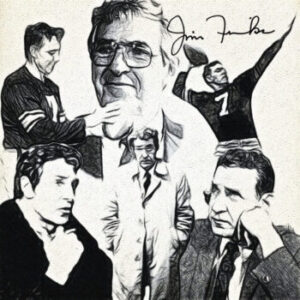
The Growth of a Philosophy
In 1957, after spending a season as an assistant coach at Notre Dame, Finks took on the role of player-coach for the Calgary Stampeders of the Canadian Football League. He played four games before sustaining an injury that ended his playing career but allowed the Stampeders to put his football intelligence to better use. Finks became the team’s general manager on October 31, 1957.
The work Finks did once he was put in charge of the Stampeders did not change the team’s fortunes overnight. The short-term fix never interested Finks. As a member of his staff in Chicago once said, “Jim Finks doesn’t build teams. He builds organizations. Then the good teams follow naturally.”
Throughout his career, Finks prioritized the draft when it came to finding young talent. He worked closely with his scouts to evaluate and identify the players he felt he could build with. Finks also considered the offensive and defensive lines to be the core of any winning team. Everything else would rest on that foundation.
The work Finks did turned the Calgary Stampeders into the winningest team in the CFL in the 1960s and delivered a Grey Cup title in 1971.
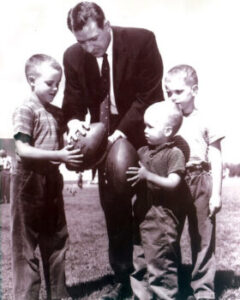
Return to the NFL
In 1964, Jim Finks returned to the NFL as general manager of the Minnesota Vikings and proved that everything he learned in Calgary about team building applied equally well in the NFL.
Defensive end Jim Marshall was already in place when Finks arrived in Minnesota. His first draft pick with the Vikings was defensive end Carl Eller and his first trade was to acquire defensive tackle Gary Larson from the Los Angeles Rams. In the 1967 NFL Draft, Finks added defensive tackle Alan Page to the group that, from that point forward, became known as “The Purple People Eaters”.
Finks also proved during his years in Minnesota that he could identify a winning coach. In 1967, when Norm Van Brocklin resigned as the Vikings head coach, Finks reached into the CFL to hire Bud Grant, who would spend 18 years as the tough, shirt sleeves wearing figurehead of the team.
By 1968, a team that had never made the postseason in its first seven years of existence won the NFC Central division. In 1969, that team went to Super Bowl IV to play the Kansas City Chiefs.
The team Finks put together in Minnesota would go to the Super Bowl a total of four times but, unfortunately in each appearance, fall short of winning the Lombardi Trophy.
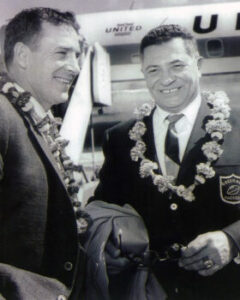
Putting the Growl Back into the Bears
In May of 1974, Finks resigned as general manager of the Vikings due to differences that arose between him and one of the team’s group of five owners. There was wild speculation around the NFL about what Finks’ next move would be.
What was unknown at the time was, in 1973, while watching another of the Chicago Bears dismal losses, George Halas Jr., or “Mugs”, turned to his father and said, “I am so sick of this”.
George Halas Sr. had run every aspect of the Bears operation since the founding of the team as the Decatur Staleys in 1919 but knew he needed to modernize, especially when it came to evaluating players. A series of terrible drafts had the Bears scraping the bottom of the NFL standings in the early 1970s.
Halas had kept an eye on what Finks was accomplishing in Minnesota and pounced on the chance to bring him to Chicago. In the most surprising part of the deal by the Bears, Finks was given complete control over football operations, becoming the first person in franchise history outside of former Bears or the Halas family to make decisions for the team.
Finks began by thoroughly scouting the Bears players as they completed the 1974 season and scoured NFL rosters to identify players he could bring in. After the team finished their 4-10 season Finks set to work. He fired head coach Abe Gibron, who had been an internal, organization hire, and brought in Jack Pardee.
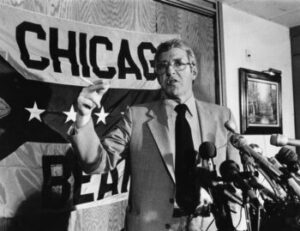
Pardee had played linebacker for the Los Angeles Rams and the Washington Redskins from 1957 to 1972 and was considered the equivalent of a coach on the field. Pardee had just finished his first season as a head coach, with the Florida Blazers of the World Football League.
Finks started rebuilding the team’s roster in the 1975 NFL Draft, his first with the Bears. The player that he selected fifth overall became as synonymous with Chicago Bears football as Dick Butkus, Gale Sayers and Bronko Nagurski. That player was running back Walter Payton.
There was also a surprise pick later in that draft, of a fullback who teamed with Payton in the Bears backfield for six seasons. In the 17th round, yes, drafts in those years went 17 rounds, Finks found Roland Harper out of Louisiana Tech.
Payton and Harper teamed to form one of the toughest backfields in the NFL In 1978, the two nearly became the first backfield to rush for over 1,000 yards each in a season. Payton rushed for 1,395 yards and Harper ran for 992 yards of his own.
In 1977, for the first time since their 1963 championship season, the Bears made the playoffs. Unfortunately, Pardee left the Bears after the season to become head coach of the Washington Redskins. To replace him, Finks turned to Minnesota and hired Neill Armstrong, the Vikings’ defensive coordinator and a coach Finks had worked with before.
The Falling Out in Chicago
Armstrong led the Bears to the playoffs in 1979, but after two straight losing seasons, in 1980 and 1981, George Halas became impatient and fired him as head coach, without consulting Finks. Halas also made the decision to replace Armstrong with Mike Ditka. That was a step too far.
Finks believed in clear delineations of power within an organization. He never interfered with how his coaches did their business and expected the same from team owners in how he operated. Once, after Virginia McCaskey had taken over as owner of the Bears after her father’s death, Finks had an encounter with her husband Ed.
Ed wanted to know if there was anything he could do to help with the team. Finks replied, “You’re an owner Ed. Own.”
Despite Halas’ interference, Finks stayed with the Bears through the 1983 NFL Draft before parting ways. In that draft the Bears added seven starters. Two of those starters, left tackle Jimbo Covert in the first round and defensive end Richard Dent in the eighth round, ended up in the Pro Football Hall of Fame.
After leaving, everything Finks built came together into, what is still considered, one of the greatest teams in NFL history, the 1985 Chicago Bears.

The Saints Start Marching
After leaving the Bears, Finks joined the Chicago Cubs as team president and chief executive officer, but football was his life. On January 14, 1986, he jumped at the chance to take charge of the New Orleans Saints, a team that hadn’t finished a season with a winning record since it entered the NFL as an expansion franchise in 1967.
This time, the turnaround was amazing to behold. Finks reached into the USFL to hire Jim Mora as the team’s head coach and in their second season at the helm, New Orleans steamrolled through the NFL to an 11-3 record and the first postseason appearance in franchise history.
In the six seasons that Finks was at the helm of the Saints they never finished below .500 and made the playoffs three more times.
The Road Comes to An End
Finks kept a note in his wallet his entire life with this saying, “In life, it’s the journey, not the arrival that counts. Does the road wind uphill all the way? Yes, to the very end.
While with the Saints, the road for Finks began winding to its finish. A chain smoker all his life, Finks was diagnosed with lung cancer on April 30, 1993, a few days after that year’s NFL Draft. On July 15, of that year Finks stepped down as general manager.
The rest that he found in stepping back from football and treatments to fight his cancer didn’t help though. Jim Finks died on May 10, 1994. His contributions to the game he loved and the teams he lifted will never be forgotten. Finks was inducted into the Pro Football Hall of Fame on July 29, 1995. The Vikings followed by inducting him into their Ring of Honor on October 18, 1998.
Finks would have been grateful for the honors, but they don’t define who he was. Jim Finks was a builder of winners.
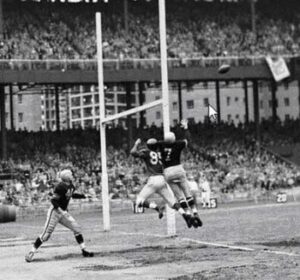
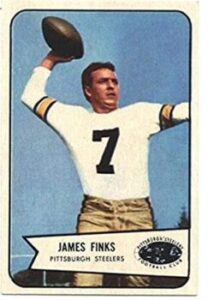
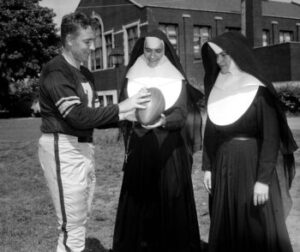
Please Share If You Liked This Article
Please Note – As an Amazon Associate I earn from qualifying purchases
More Posts From Pro Football In The 1970s
Exploring the Career of Hall of Fame Offensive Guard Larry Little
As many of you may know, I recently wrote a...
Read MoreRemembering the 1972 Cleveland Browns
How many NFL teams during the 1970s do you remember...
Read MoreThe Future Is Now With George Allen
When George Allen became the new head coach for the...
Read MoreGreat NFL Linebackers Who Are Not in the Hall of Fame
There are many great pro linebackers who are enshrined...
Read More